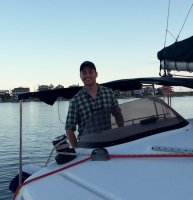
Student
Matthew Szulanczyk
Annapolis, MD, USA
More User info
Captain Level IV
Status: Really Big Time Sailor
Qualified days: 120
Posted 2015, Aug 15 16:48
Can anyone recommend a good resource for obtaining Tide Curves for specific places in the US? I am not talking about the NOAA tide charts but rather the curve used for predicting tide at a specific time. The paper method! These were used in the RYA Day Skipper course and I can only find them for UK based ports. Are these only UK specific? Thank you.

Student
Giulio Sante Giraldi
Crawley, United Kingdom
More User info
Crew Level 0
Status: Sailor
Qualified days: 0
Posted 2015, Aug 16 09:39
In the conversione using deviation exercise, the deviation table represents at 300º Deviation is 0.0 and at 330º deviation is 1.5E,
The Compass bearing is 310º, so imho the Deviation should be 0.5E as in between 0.0 and 1.5, in the exercise though the deviation is marked as 2.0E.
I don't understand why?
Thanks,

Student
Giulio Sante Giraldi
Crawley, United Kingdom
More User info
Crew Level 0
Status: Sailor
Qualified days: 0
Posted 2015, Aug 24 21:33
Hello,
I didn't understand how to decide if a given day is neaps or spring tide,
could you please explain me more?
Thanks,
Giulio
![avatar]()
Student
Eric Langley
Newport, RI, USA
More User info
Crew Level 0
Status: Sailor
Qualified days: 3
Posted 2015, Oct 30 13:15
You are sailing along on heading 50° "psc" (54° Mag)...
PSC stands for Per Ships Compass

Student
Ryan hogan
los altos, CA, USA
More User info
Crew Level 0
Status: Sailor
Qualified days: 0
Posted 2015, Dec 04 17:00
Why is deviation the same in all headings for the example question. It appears that from the table given above that the deviation should be different, unless they are unrelated?

Student
Ryan hogan
los altos, CA, USA
More User info
Crew Level 0
Status: Sailor
Qualified days: 0
Posted 2015, Dec 05 20:19
Grant, how accurate are the answers expected to be? I have double checked my answer three times and have not come up with a reason why Lat 46°14'.74N Long 005°50'.20W is the answer and not 46deg14'.85N 5deg51'.00W. Even assuming that the variation number I used was not 7.2deg W, the transit line does not pass through the correct lat/long answer given by the self grading function. In checking this, I show that the lat/long given (Lat 46°14'.74N Long 005°50'.20W) shows a 358(M) bearing to the Bayview Hotel rather than 000 (M). Perhaps I am splitting hairs and this difference is negligible for the purposes of final exam grading? Thoughts?
Thanks,
Ryan

Student
Ryan hogan
los altos, CA, USA
More User info
Crew Level 0
Status: Sailor
Qualified days: 0
Posted 2015, Dec 11 05:19
What curve for Namely harbor should be used in this example, Spring or Neaps? I chose Neaps, however, from the answer bank, this seems to be incorrect and unsure why Spring would be chosen over Neaps.

Student
Paul Schwendeman
Wexford, PA, USA
More User info
Skipper (small keelboat) Level I
Status: Sailor
Qualified days: 16
Posted 2016, Jan 21 22:49
I've very confused in this section! Why is a curve used at the end of the vector line and not a straight line? How is the length of the vector line determined? Do I use the time/speed formula, determine distance over one hour and use latitude scale on left side of chart? I get the DR course line and the COG line but can't grasp the vector information and where to place it.

Student
Jane Whild
Stoke Goldington, United Kingdom
More User info
Crew Level 0
Status: Sailor
Qualified days: 2
Posted 2016, Feb 20 16:02
Hi Grant
Regarding the example below, to clarify my understanding, won't more of the rock will be visible at 1030 at low tide, not below the surface?
" This above means that in Eastport on the 31th August at 1030 am, the depth of the water will be 2.6 feet below the chart datum depth at any point. e.g. if the harbor reads 7.0 feet deep at a certain point, then the real depth at 1030 will be 7.0 - 2.6 = 4.4m. Or if the chart shows a rock at 2 ft above the datum, at 1030 it will be below the surface. For a 5 ft draft and at 4.4 ft real depth, this could be a grounding situation, even though the chart says 7 ft.

Student
Darroch Cahen
Astoria, OR, USA
More User info
Captain Level IV
Status: Big Time Sailor
Qualified days: 182
Posted 2016, Apr 28 23:31
When teaching the basic navigation skills for U.S. Sail & Power Squadron the memory reminder for calculating Speed, Time or Distance is "Sixty D Street". That is 60*Distance = Speed * Time. Perhaps this will help NauticEd Students as well.